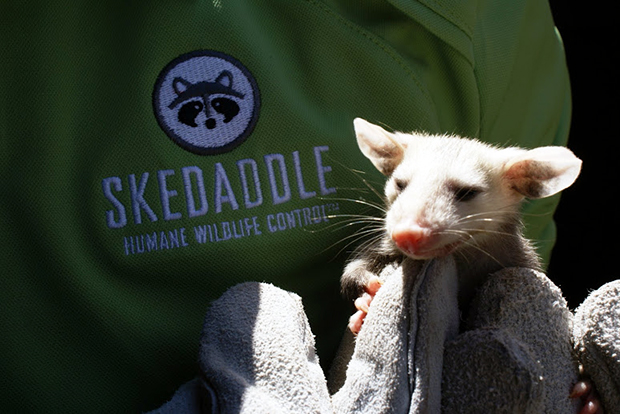
This week, Skedaddle Humane Wildlife Control responded to a call from a homeowner in Hamilton who had an opossum in their shed. We don’t get many calls for opossums as compared to raccoons or squirrels, although sometimes we will receive calls from homeowners who think they have a big rat in their backyard, but it turns out to be an opossum.
“About 20-25 years ago we started to get calls about opossums in the Niagara area, these are more of a southern animal that have moved up to Canada and slowly over the past 20-25 years they are making their way around Lake Ontario, from Niagara and Hamilton and further up the lake into Toronto,” said Skedaddle Humane Wildlife Control President and CEO Bill Dowd. “So we are starting to see more and more. A lot of the time they will be in garages and sheds. Opossums are scavengers, and they visit human homes or settlements to raid garbage cans, dumpsters, and other containers.”
Opossums are the only marsupial animal in North America, meaning, like a kangaroo their babies are born in a pouch. Babies immediately crawl into the mother’s pouch, where they continue to develop. As they get larger, they will go in and out of the pouch and sometimes ride on the mother’s back as she hunts for food.
Opossums may give birth to as many as 20 babies in a litter, but fewer than half of them survive. Some never even make it as far as the pouch.

Opossum babies are born in a pouch. Babies immediately crawl into the mother’s pouch, where they continue to develop. As they get larger, they will go in and out of the pouch and sometimes ride on the mother’s back as she hunts for food.
Because of their sharp claws and long tail that can grip onto things, opossums are excellent climbers, and spend much of their time in trees. They have opposable “thumbs.” The opossum’s “thumbs” (called hallux) are on its rear feet, and allow for opossum’s strong climbing skills. Primates and opossums are the only mammals with opposable first toes.
They also have prehensile tails which are adapted for grabbing and wrapping around things like tree limbs. The opossum can hang from its tail for short periods of time, but it doesn’t sleep hanging from its tail, as some people think. Opossums have been observed carrying bundles of grasses and other materials by looping their tail around them.
What to do if you have opossums living on your property:
Skedaddle Humane Wildlife Control has received calls from homeowners in Burlington, Mississauga and Oakville who have had opossums living in their attics, sheds and garages as well as under decks.
Accessing an opossum den can be a challenge. Skedaddle Humane Wildlife Control uses specialized hands-on techniques to carefully remove the opossum from their burrow. If there are baby opossums, they are placed inside a heated baby box so that they can be safely relocated by their mother to one of her multiple den sites.
The key to getting the opossum out from under the structure is to permanently block access. Part of our process involves taking specific measures designed to prevent future opossum intrusions. Our Wildlife Specialists will not only seal the entry point after removal, but will also protect any potential openings by burying heavy gauge screen deep into the ground. We then deodorize the surrounding areas to deter other opossum or other animals, like skunks and raccoons, from making your deck, porch or shed their home.
If an opossum is in your attic, similar measures will be taken. The opossum will be removed; the entry hole or access point sealed, and then the deodorized and cleaning begins. Insulation may need to be replaced as well, if it has been contaminated by the opossum’s feces or urine.
If you have an opossum on your property that has made a den under a structure on your property, or is in your attic, give Skedaddle Humane Wildlife Control today: 1-888-592-0387.



